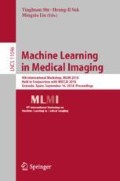Abstract
Numerous methods have been proposed to capture early hippocampus alterations caused by Alzheimer’s disease. Among them, patch-based grading approach showed its capability to capture subtle structural alterations. This framework applied on hippocampus obtains state-of-the-art results for AD detection but is limited for its prediction compared to the same approaches based on whole-brain analysis. We assume that this limitation could come from the fact that hippocampus is a complex structure divided into different subfields. Indeed, it has been shown that AD does not equally impact hippocampal subfields. In this work, we propose a graph-based representation of the hippocampal subfields alterations based on patch-based grading feature. The strength of this approach comes from better modeling of the inter-related alterations through the different hippocampal subfields. Thus, we show that our novel method obtains similar results than state-of-the-art approaches based on whole-brain analysis with improving by 4 percent points of accuracy patch-based grading methods based on hippocampus.
Data used in preparation of this article were obtained from the Alzheimer’s Disease Neuroimaging Initiative (ADNI) database (adni.loni.usc.edu). As such, the investigators within the ADNI contributed to the design and implementation of ADNI and/or provided data but did not participate in analysis or writing of this report. A complete listing of ADNI investigators can be found at: http://adni.loni.usc.edu/wp-content/uploads/how_to_apply/ADNI_Acknowledgement_List.pdf.
K. Hett et al.: the Alzheimer’s Disease Neuroimaging Initiative
Access this chapter
Tax calculation will be finalised at checkout
Purchases are for personal use only
References
Avants, et al.: A reproducible evaluation of ANTs similarity metric performance in brain image registration. NeuroImage 54(3), 2033–2044 (2011)
Coupé, P., et al.: Scoring by nonlocal image patch estimator for early detection of Alzheimer’s disease. NeuroImage: Clin. 1(1), 141–152 (2012)
Coupé, et al.: Collaborative patch-based super-resolution for diffusion-weighted images. NeuroImage 83, 245–261 (2013)
Giraud, et al.: An optimized patchmatch for multi-scale and multi-feature label fusion. NeuroImage 124, 770–782 (2016)
Hett, K., et al.: Adaptive fusion of texture-based grading: application to Alzheimer’s disease detection. In: International Workshop on Patch-based Techniques in Medical Imaging, pp. 82–89. Springer, Berlin (2017)
Kerchner, et al.: Hippocampal CA1 apical neuropil atrophy and memory performance in Alzheimer’s disease. NeuroImage 63(1), 194–202 (2012)
Liu, et al.: Slep: sparse learning with efficient projections. Ariz. State Univ. 6(491), 7 (2009)
Manjón, et al.: Adaptive non-local means denoising of MR images with spatially varying noise levels. J. Magn. Reson. Imaging 31(1), 192–203 (2010)
Moradi, et al.: Machine learning framework for early MRI-based Alzheimer’s conversion prediction in MCI subjects. NeuroImage 104, 398–412 (2015)
Romero, et al.: Hips: a new hippocampus subfield segmentation method. NeuroImage 163, 286–295 (2017)
Sørensen, L., et al.: Differential diagnosis of mild cognitive impairment and Alzheimer’s disease using structural MRI cortical thickness, hippocampal shape, hippocampal texture, and volumetry. NeuroImage: Clin. 13, 470–482 (2017)
Suk, et al.: Deep ensemble learning of sparse regression models for brain disease diagnosis. Med. Image Anal. 37, 101–113 (2017)
Tong, et al.: Multiple instance learning for classification of dementia in brain MRI. Med. Image Anal. 18(5), 808–818 (2014)
Tong, et al.: A novel grading biomarker for the prediction of conversion from mild cognitive impairment to Alzheimer’s disease. IEEE Trans. Biomed. Eng. 64(1), 155–165 (2017)
rujillo-Estrada, et al.: Early neuronal loss and axonal/presynaptic damage is associated with accelerated amyloid-\(\beta \) accumulation in a\(\beta \)pp/ps1 Alzheimer’s disease mice subiculum. J. Alzheimer’s Dis. 42(2), 521–541 (2014)
Tustison, et al.: N4 ITK: improved N3 bias correction. IEEE Trans. Med. Imaging 29(6), 1310–1320 (2010)
Winterburn, et al.: A novel in vivo atlas of human hippocampal subfields using high-resolution 3 T magnetic resonance imaging. NeuroImage 74, 254–265 (2013)
Wolz, et al.: Multi-method analysis of MRI images in early diagnostics of Alzheimer’s disease. PloS One 6(10), e25446 (2011)
Acknowledgement
This study has been carried out with financial support from the French State, managed by the French National Research Agency (ANR) within the project DeepVolbrain and in the frame of the investments for the future program IdEx Bordeaux (HL-MRI ANR-10-IDEX-03-02), Cluster of excellence CPU, TRAIL (BigDataBrain ANR-10-LABX- 57) and the Spanish DPI2017-87743-R grant from the Ministerio de Economia, Industria y Competitividad of Spain.
Author information
Authors and Affiliations
Corresponding author
Editor information
Editors and Affiliations
Rights and permissions
Copyright information
© 2018 Springer Nature Switzerland AG
About this paper
Cite this paper
Hett, K., Ta, VT., Manjón, J.V., Coupé, P. (2018). Graph of Hippocampal Subfields Grading for Alzheimer’s Disease Prediction. In: Shi, Y., Suk, HI., Liu, M. (eds) Machine Learning in Medical Imaging. MLMI 2018. Lecture Notes in Computer Science(), vol 11046. Springer, Cham. https://doi.org/10.1007/978-3-030-00919-9_30
Download citation
DOI: https://doi.org/10.1007/978-3-030-00919-9_30
Published:
Publisher Name: Springer, Cham
Print ISBN: 978-3-030-00918-2
Online ISBN: 978-3-030-00919-9
eBook Packages: Computer ScienceComputer Science (R0)

